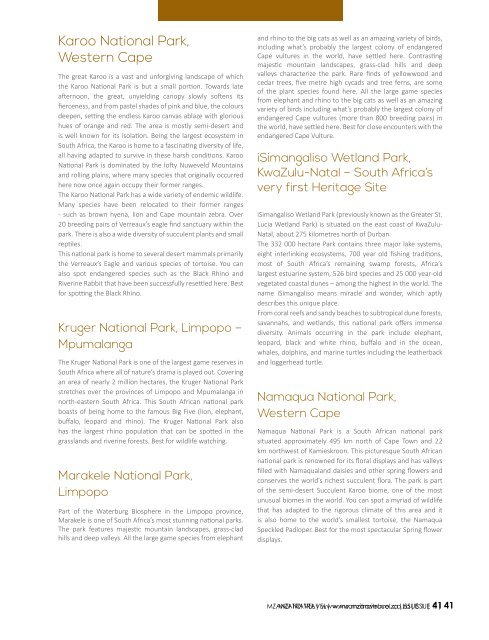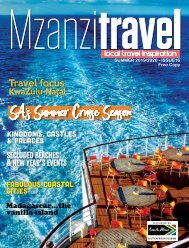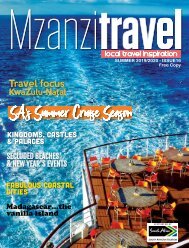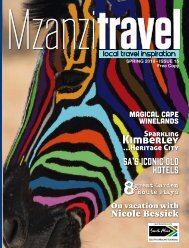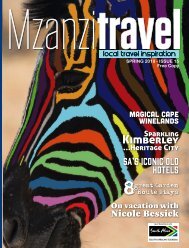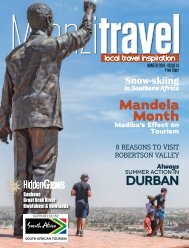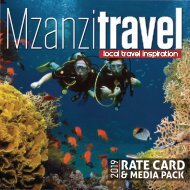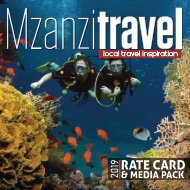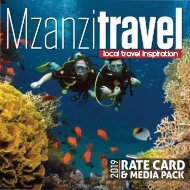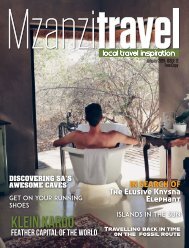MZANZI TRAVEL - ISSUE 1
MZANZI TRAVEL is a glossy, full-colour quarterly, A4 publication that sets out to showcase, foster and promote whatever South Africa has to offer to both local and international tourists.
MZANZI TRAVEL is a glossy, full-colour quarterly, A4 publication
that sets out to showcase, foster and promote whatever South
Africa has to offer to both local and international tourists.
- No tags were found...
You also want an ePaper? Increase the reach of your titles
YUMPU automatically turns print PDFs into web optimized ePapers that Google loves.
Karoo National Park,<br />
Western Cape<br />
The great Karoo is a vast and unforgiving landscape of which<br />
the Karoo National Park is but a small portion. Towards late<br />
afternoon, the great, unyielding canopy slowly softens its<br />
fierceness, and from pastel shades of pink and blue, the colours<br />
deepen, setting the endless Karoo canvas ablaze with glorious<br />
hues of orange and red. The area is mostly semi-desert and<br />
is well known for its isolation. Being the largest ecosystem in<br />
South Africa, the Karoo is home to a fascinating diversity of life,<br />
all having adapted to survive in these harsh conditions. Karoo<br />
National Park is dominated by the lofty Nuweveld Mountains<br />
and rolling plains, where many species that originally occurred<br />
here now once again occupy their former ranges.<br />
The Karoo National Park has a wide variety of endemic wildlife.<br />
Many species have been relocated to their former ranges<br />
- such as brown hyena, lion and Cape mountain zebra. Over<br />
20 breeding pairs of Verreaux’s eagle find sanctuary within the<br />
park. There is also a wide diversity of succulent plants and small<br />
reptiles.<br />
This national park is home to several desert mammals primarily<br />
the Verreaux’s Eagle and various species of tortoise. You can<br />
also spot endangered species such as the Black Rhino and<br />
Riverine Rabbit that have been successfully resettled here. Best<br />
for spotting the Black Rhino.<br />
Kruger National Park, Limpopo –<br />
Mpumalanga<br />
The Kruger National Park is one of the largest game reserves in<br />
South Africa where all of nature’s drama is played out. Covering<br />
an area of nearly 2 million hectares, the Kruger National Park<br />
stretches over the provinces of Limpopo and Mpumalanga in<br />
north-eastern South Africa. This South African national park<br />
boasts of being home to the famous Big Five (lion, elephant,<br />
buffalo, leopard and rhino). The Kruger National Park also<br />
has the largest rhino population that can be spotted in the<br />
grasslands and riverine forests. Best for wildlife watching.<br />
Marakele National Park,<br />
Limpopo<br />
Part of the Waterburg Biosphere in the Limpopo province,<br />
Marakele is one of South Africa’s most stunning national parks.<br />
The park features majestic mountain landscapes, grass-clad<br />
hills and deep valleys. All the large game species from elephant<br />
and rhino to the big cats as well as an amazing variety of birds,<br />
including what’s probably the largest colony of endangered<br />
Cape vultures in the world, have settled here. Contrasting<br />
majestic mountain landscapes, grass-clad hills and deep<br />
valleys characterize the park. Rare finds of yellowwood and<br />
cedar trees, five metre high cycads and tree ferns, are some<br />
of the plant species found here. All the large game species<br />
from elephant and rhino to the big cats as well as an amazing<br />
variety of birds including what’s probably the largest colony of<br />
endangered Cape vultures (more than 800 breeding pairs) in<br />
the world, have settled here. Best for close encounters with the<br />
endangered Cape Vulture.<br />
iSimangaliso Wetland Park,<br />
KwaZulu-Natal – South Africa’s<br />
very first Heritage Site<br />
iSimangaliso Wetland Park (previously known as the Greater St.<br />
Lucia Wetland Park) is situated on the east coast of KwaZulu-<br />
Natal, about 275 kilometres north of Durban.<br />
The 332 000 hectare Park contains three major lake systems,<br />
eight interlinking ecosystems, 700 year old fishing traditions,<br />
most of South Africa’s remaining swamp forests, Africa’s<br />
largest estuarine system, 526 bird species and 25 000 year-old<br />
vegetated coastal dunes – among the highest in the world. The<br />
name iSimangaliso means miracle and wonder, which aptly<br />
describes this unique place.<br />
From coral reefs and sandy beaches to subtropical dune forests,<br />
savannahs, and wetlands, this national park offers immense<br />
diversity. Animals occurring in the park include elephant,<br />
leopard, black and white rhino, buffalo and in the ocean,<br />
whales, dolphins, and marine turtles including the leatherback<br />
and loggerhead turtle.<br />
Namaqua National Park,<br />
Western Cape<br />
Namaqua National Park is a South African national park<br />
situated approximately 495 km north of Cape Town and 22<br />
km northwest of Kamieskroon. This picturesque South African<br />
national park is renowned for its floral displays and has valleys<br />
filled with Namaqualand daisies and other spring flowers and<br />
conserves the world’s richest succulent flora. The park is part<br />
of the semi-desert Succulent Karoo biome, one of the most<br />
unusual biomes in the world. You can spot a myriad of wildlife<br />
that has adapted to the rigorous climate of this area and it<br />
is also home to the world’s smallest tortoise, the Namaqua<br />
Speckled Padloper. Best for the most spectacular Spring flower<br />
displays.<br />
<strong>MZANZI</strong> <strong>MZANZI</strong> <strong>TRAVEL</strong>| <strong>TRAVEL</strong>| www.mzanzitravel.co.za|<strong>ISSUE</strong> 1 | 141|<br />
41


